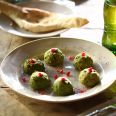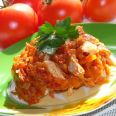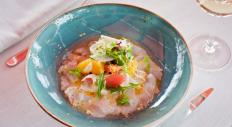Best Dishes of Georgian Cuisine
Sakartvelo – the land of the Georgians – has a long history that naturally reflected in the establishment of its national culture and way of life.
The general name Georgian cuisine includes culinary features of many ethnic groups, and they are frequently conflicting

Sakartvelo – the land of the Georgians – has a long history that naturally reflected in the establishment of its national culture and way of life.
The general name "Georgian cuisine" includes culinary features of many ethnic groups, and they are frequently conflicting. The rich and original Georgian cuisine has retained its national specificity. However, there is considerable difference between the culinary art of western and eastern Georgia. The common feature for both parts of Georgia is consumption of wines and various fresh herbs – two obligatory dishes included in any dinner, fresh herbs are served at any time of the year for breakfast, lunch and dinner. By season, it can be parsley, dill, damsons, leek, tarragon, mint, watercress (tsitsmat), basil, savory, spring onions, estragon and a great variety of other fresh herbs grown in Georgia. Who knows, maybe fresh herbs are the secret of health and longevity of Georgians?
Typical of Georgian cuisine is simplicity of preparation. If you take a closer look, you will see that in Georgia they eat everything – there are no religious or cultural restriction in the choice of meat. Due to its unique geographical location and the diligence of its inhabitants there is a huge choice of vegetables and fruit grown here in Georgia. Sea, river and lake fish are all eaten as Georgia is generously gifted with the nature, its amazing variety caused by its geographical position and extraordinary landscape diversity.
Georgia has a separate holiday - a holiday of rtveli vintage, it falls on September. In villages everybody, even children, collects grapes putting them in wicker baskets. Balconies and rooms walls are covered with dried bunches. Grapes of the first gathering are used to make sweet foamy madzhari. Oh, how much you are missing, if you have never tried this young wine – such pleasure is worth visiting Georgia. Usually it can be bought at any street market, especially on holidays, such wine is not matured for years, but drunk as soon as it is ready. (In fact, wine lines of Georgian markets deserve of special description, any wine seller would love to pour to you a glass or two to taste, so an unsophisticated "taster" might find it very difficult to remain standing after probing all the assortment. Therefore if you should visit wine lines of a Georgian market – try wine not by glasses, but by sips, and be sure you praise it in every possible way.)
As for celebratory feasts, the Georgians always begin them with a toast, and, as a rule, finish them with "Suliko" song.
Khashi (dense)
200g beef legs
250g tripe
100g maw
1 cup broth
1 root garlic
20g smoked lard
10g butter
25g white Georgian bread
30g milk
Soak beef legs for a day, changing water every 3 hours, or wash them, burn, scrape with a knife, and wet for a day.
Halve them, grind the lard, put into a saucepan. Wash and slice the tripe. Combine with maw in the saucepan. Cover with a lid and simmer at strong heat in own juice. When the juice is boiled away, add water and cook until the meat is easily separated from bones. Soak bread (without crust) in milk. 15 minutes before it is ready, add bread, butter and salt (spices to taste) into the saucepan Separately dissolve pounded garlic with broth and serve to the table.
Tsotskhali
500g trout
2g alum
fresh parsley and celery
Clean and gill the fish. Put the fish into the saucepan. If it is small put it whole; if it is large cut into portioned pieces. Cook with alum in salted water. Put the boiled fish on a dish and decorate with fresh herbs.
Kupaty
1kg beef filet
100g lard
2 onions
guts (as many as required)
ground black pepper
1 tbsp garlic
1 pomegranate (or 0.5 cup barberry)
cinnamon
Grind meat, lard, and onions. Add salt, pepper, cinnamon, pounded garlic, 2 tablespoons of water or broth. Mix everything well, add pomegranate or barberry seeds. Mix again very carefully not to crumple the pomegranate seeds. Carefully wash the guts, and soak them. Tie the prepared gut from one end with twine. Insert a funnel in the open end of the gut and fill it with the forcemeat not too densely (you can use the upper part of a plastic bottle instead). Tie up with twine (the length of kupaty is 20-30cm). Tie the ends and immerse into boiling water for one minute. Take out, cool down and keep in the air (2 weeks max). Before eating, put kupaty on a heated frying pan with oil or fat, fry on both sides and serve. Kupaty are good when made of pork-and-beef mix.
Grape Leaves Tolma
500g beef filet
200g onions
1 egg
grape leaves (as much as required)
1L matsoni (sour milk)
powdered sugar
ground cinnamon
ground black pepper
Grind meat with onions, add salt and pepper. Add whipped egg. Mix everything. Pour boiling water over grape leaves and leave them in hot water for 8 minutes. Drain the water, put the leaves on a colander. Then spread them out on a board. Put forcemeat on each leave and roll it (see Figure). Put everything into a low saucepan, add water so that it just covers the contents, and cook 1-1.5 hour at low heat. Put matsoni on a napkin and hang up or put on another napkin. As soon as the napkin gets wet, wring it out and continue so until matsoni thickens. Then whip it. Lay the prepared tolma on a dish, pour the matsoni atop, sprinkle with powdered sugar and pounded cinnamon.
Beef with Aubergines
700g fat tenderloin
7 medium aubergines
600g onions
1kg tomatoes
5 sweet peppers
4 cloves garlic
string pepper
fresh parsley, coriander, savory, basil, dill
Cut meat into portion pieces, sprinkle with ground string pepper, tenderize with a mallet, and put in a bowl. Slice aubergines, sprinkle with plenty of salt, and leave to rest for 20 minutes. Then put them on a colander and wash. Slice sweet pepper into circles. Chop fresh parsley, savory, coriander, and dill fine. Scald tomatoes with boiling water, peel and slice into circles. Slice onions fine. Pound garlic with salt. Put the layers of onions, aubergines, herbs, garlic, meat, sweet pepper, and tomatoes into a low saucepan with a wide bottom. Put the saucepan on low heat, bring to boil, add salt and 0.5 cup of broth (or hot water). 10 minutes before the meat is ready add a shoot of basil.
Lamb with Quince
0.5kg lamb
50g lamb lard
3 onions
2-3 quinces
1 tbsp sugar
ground cinnamon, coriander
Wash the meat. Slice and put in a saucepan with boiling water. Skim. Cook until half-ready. Melt fat. Slice onions. Peel and core quince, cut the pulp into 0.5cm segments. Put onions in a frying pan with boiling fat and fry until goldish. Add quince, turn down heat, cover with a lid, and stew until the quince is soft. Filter the broth, take quarter of a cup, and pour it into the frying pan with onions and quince. Stew 5 minutes. Pour the rest of the broth into the saucepan with meat, put on the heat, add the contents of the frying pan. Finely chop coriander, mix it with cinnamon, and add into the saucepan. Salt it, take off the heat, and serve in a soup tureen.
Stewed Lamb in Pomegranate Sauce
500g fat lamb
50g fat tail
0.5 cup pomegranate juice
2 onions
coriander, string pepper
Melt fat tail in a saucepan with low sides. Put sliced meat into the boiling fat, cook it until ready, add salt and string pepper. Put the meat into another saucepan, and add a cup of water into the first one. As soon as the water begins to boil, pour it into the saucepan with meat, stew 20 minutes at low heat. Then drain all the juice, add pomegranate juice, finely sliced onions and coriander. Mix it all and put on a dish. Fill with sauce and serve to the table.
Khachapuri
1kg wheat flour
0.5L milk or 2 cups matsoni
4 eggs
500g young lightly marinated Imeretin cheese
pinch salt
1 tbsp melted butter
Grind cheese, add 2 eggs, mix. Sift flour and make a deepening. Warm up milk, add salt and 2 eggs, mix. Pour it into the deepening. Make pastry and divide it into 4 parts. Roll each out thin, put cheese in the middle and pinch tight. Heat a cast-iron frying pan, put khachapuri pinched side down, cover the frying pan with a lid and bake in the oven. Turn over khachapuri and bake without a lid. When the khachapuri is ready, butter them and serve hot.
Churchkhela
Churchkhela is, perhaps, the most popular sweet in the Georgian cuisine. In Russia it can be seen almost at any street market – you have seen it for sure. They look like long thin sausages of red claret colour. They are very delicious and easy to cook, but you will need "alive" grape juice (freshly squeezed), nuts and corn flour. Hazelnuts (or walnuts) are stringed on a thick thread (such as "orris") with a needle. The thread should be 20-25 centimetres long, and the first nut - 4-5cm from the thread end with the needle. Put 10 nuts on each thread. Make as many churchkhelas as you like. Then prepare a special hot mousse (described below), lower each string in it up to the top nut (hold the string by the loose end) and take out immediately. As soon as it has cooled down, dip it in the mousse again, and hang up again to let it cool down. Repeat it 8 to 10 times thus making churchkhela thicker layer by layer until the thread without a nut becomes 3 to 3.5cm in diameter. Then dry up churchkhela. You can keep them in the fridge or just somewhere in your room. They do not get spoiled, only hardened, but they are very unlikely to wait for so long. Mousse for churchkhela is made of fresh grape juice with pulp and corn flour in the following proportion – 1 litre of juice, 2 tablespoons of flour, and boiled until very dense (like kissel or custard). Boil as usual kissel.
Brindzhula
2 cups wheat flour
1 cup milk or matsoni
1 egg
pinch salt
2 tbsp sugar
0.5 teaspoon soda
2 crystals of citric acid (or wine vinegar)
100g Imereti light-salt cheese
Sift flour into a bowl, make a deepening, add milk or matsoni. Separately mix egg, salt, sugar, soda and vinegar or citric acid. Shake everything well and add into the flour, make liquid dough like for pancakes. Pour onto heated baking tray or ketsi 2-3cm thick, cover with 3-4cm grated cheese, cover with another ketsi, cover with hot coals. If you use a baking tray then pour the dough on one tray, cover with another one, and bake.
Pkhali from the Chef of Kharcho Restaurant
Pkhali is one of the most popular and beloved by many people dishes of the Georgian cuisine. It is very easy to cook and there are so many variations. You may use almost any vegetables and herbs to co...
Marinated cod
There are lots of recipes to cook marinated fish. A great variety of such recipes consists of frying pieces of fish in oil. I would like to offer you a recipe of lean fish in marinade. It gets tasty, ...
Fresh sea bass carpaccio with citrus sauce
Hospitable and vivacious brand-chef of Park Giuseppe Restaurant Sergey Lasarev showed us how to cook fresh sea bass carpaccio with citrus sauce – a simple but dainty food.







